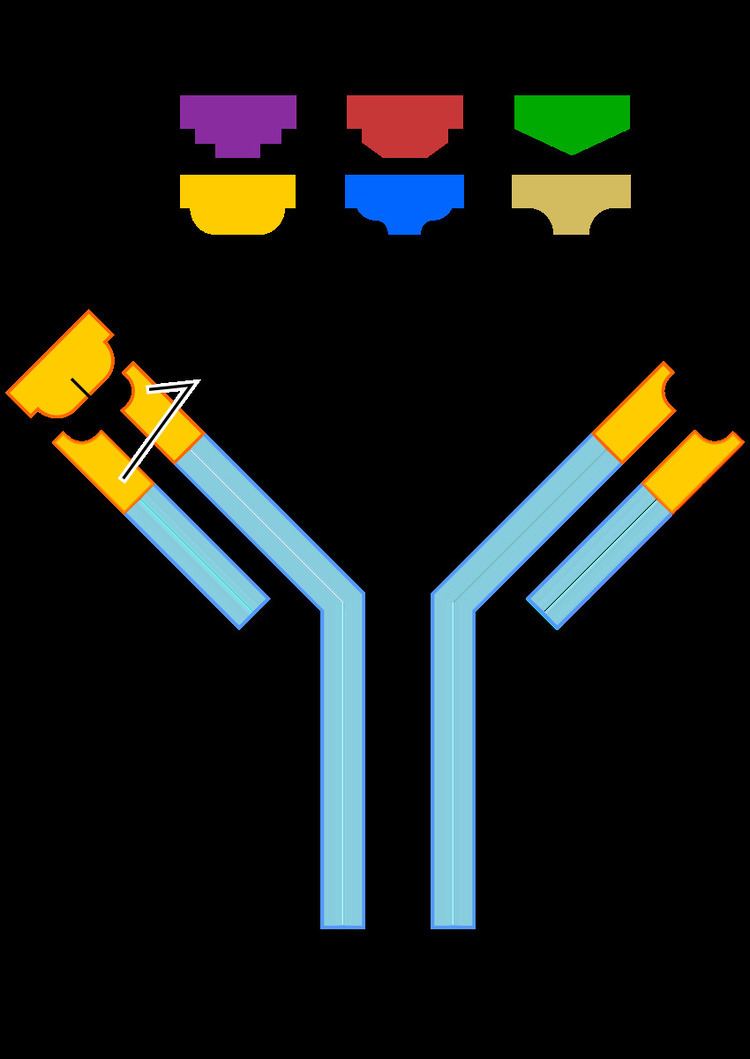 | ||
In immunology, an antigen is a molecule capable of inducing an immune response on the part of the host organism, though sometimes antigens can be part of the host itself. In other words, an antigen is any substance that causes an immune system to produce antibodies against it. Each antibody is specifically produced by the immune system to match an antigen after cells in the immune system come into contact with it; this allows a precise identification of the antigen and the initiation of a tailored response. The antibody is said to "match" the antigen in the sense that it can bind to it thanks to adaptations performed to a region of the antibody; because of this, many different antibodies can be produced, with specificity to bind many different antigens while sharing the same basic structure. In most cases, an antibody can only bind one specific antigen; in some instances, however, antibodies may bind more than one antigen.
Contents
An antigen is a molecule that binds to Ag-specific receptors, but cannot necessarily induce an immune response in the body by itself. Antigens are usually peptides, polysaccharides or lipids. In general, molecules other than peptides (saccharides and lipids) qualify as antigens but not as immunogens since they cannot elicit an immune response on their own. Furthermore, for a peptide to induce an immune response (activation of T-cells by antigen-presenting cells) it must be a large enough size, since peptides too small will also not elicit an immune response. The term antigen originally described a structural molecule that binds specifically to an antibody. It expanded to refer to any molecule or a linear molecular fragment that can be recognized by highly variable antigen receptors (B-cell receptor or T-cell receptor) of the adaptive immune system.
The antigen may originate from within the body ("self-antigen") or from the external environment ("non-self"). The immune system usually does not react to self-antigens under normal homeostatic conditions due to negative selection of T cells in the thymus and is supposed to identify and attack only "non-self" invaders from the outside world or modified/harmful substances present in the body under distressed conditions.
Antigen presenting cells present antigens in the form of peptides on histocompatibility molecules. The T cells of the adaptive immune system recognize the antigens. Depending on the antigen and the type of the histocompatibility molecule, different types of T cells are activated. For T-Cell Receptor (TCR) recognition, the peptide must be processed into small fragments inside the cell and presented by a major histocompatibility complex (MHC). The antigen cannot elicit the immune response without the help of an immunologic adjuvant. Similarly, the adjuvant component of vaccines plays an essential role in the activation of the innate immune system.
An immunogen is a substance (or adduct) that is able to trigger a humoral (innate) and/or cell-mediated immune response. It first initiates an innate immune response, which then causes the activation of the adaptive immune response. An antigen binds the highly variable immunoreceptor products (B-cell receptor or T-cell receptor) once these have been generated. All immunogen molecules are also antigens, although the reverse is not true.
At the molecular level, an antigen can be characterized by its ability to bind to an antibody's variable Fab region. Different antibodies have the potential to discriminate among specific epitopes present on the antigen surface. A hapten is a small molecule that changes the structure of an antigenic epitope. In order to induce an immune response, it needs to be attached to a large carrier molecule such as a protein. Antigens are usually proteins and polysaccharides, and less frequently, lipids. This includes parts (coats, capsules, cell walls, flagella, fimbrae, and toxins) of bacteria, viruses, and other microorganisms. Lipids and nucleic acids are antigenic only when combined with proteins and polysaccharides. Non-microbial non-self antigens can include pollen, egg white and proteins from transplanted tissues and organs or on the surface of transfused blood cells. Vaccines are examples of antigens in an immunogenic form, which are intentionally administered to induce the memory function of adaptive immune system toward the antigens of the pathogen invading the recipient.
Etymology
Paul Ehrlich coined the term antibody (in German Antikörper) in his side-chain theory at the end of 19th century. In 1899, Ladislas Deutsch (Laszlo Detre) (1874–1939) named the hypothetical substances halfway between bacterial constituents and antibodies "substances immunogenes ou antigenes" (antigenic or immunogenic substances). He originally believed those substances to be precursors of antibodies, just as zymogen is a precursor of an enzyme. But, by 1903, he understood that an antigen induces the production of immune bodies (antibodies) and wrote that the word antigen is a contraction of antisomatogen (Immunkörperbildner). The Oxford English Dictionary indicates that the logical construction should be "anti(body)-gen".
Terminology
Antigenic specificity
Antigenic specificity is the ability of the host cells to recognize an antigen specifically as a unique molecular entity and distinguish it from another with exquisite precision. Antigen specificity is due primarily to the side-chain conformations of the antigen. It is measurable and need not be linear or of a rate-limited step or equation.
